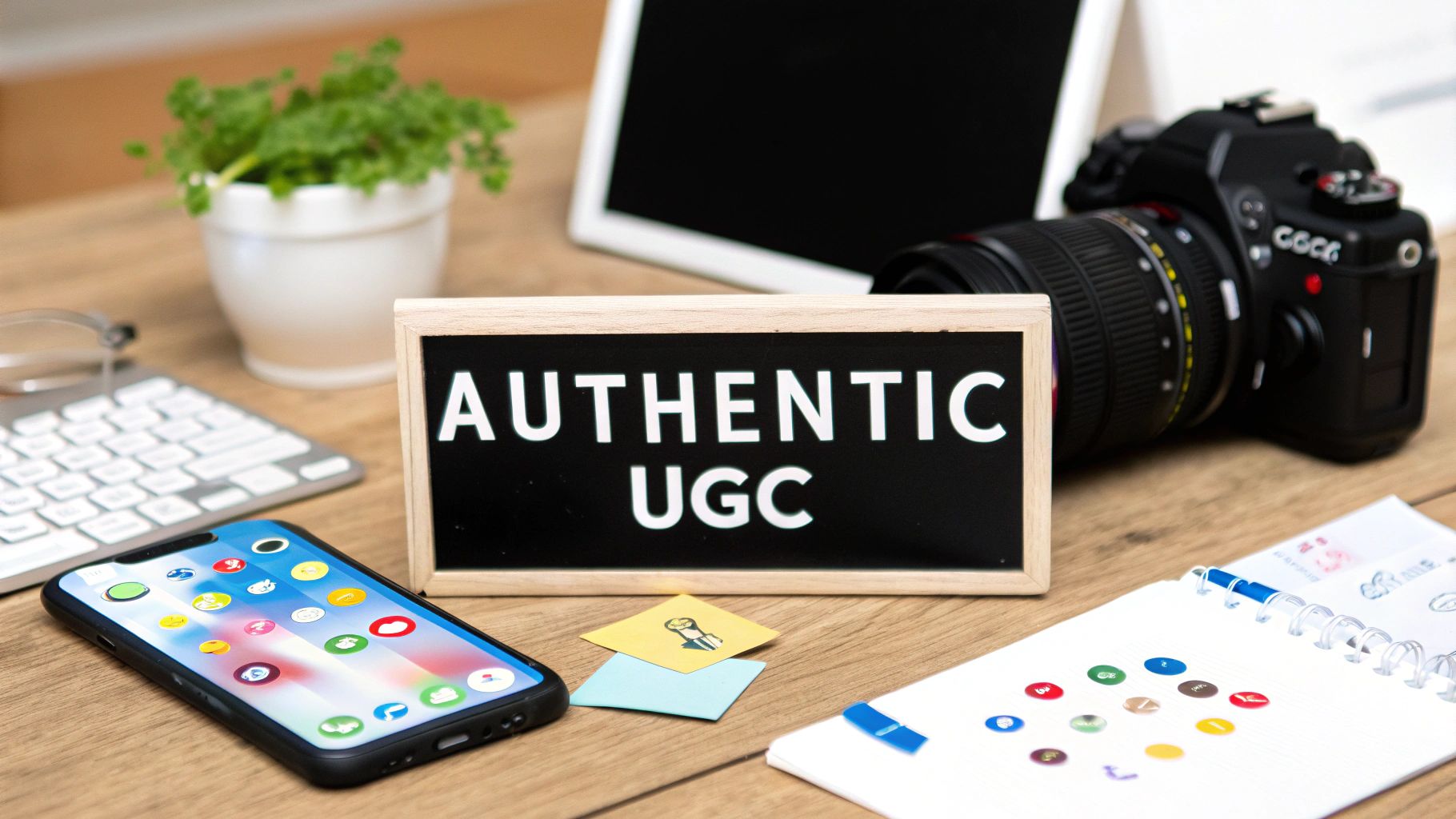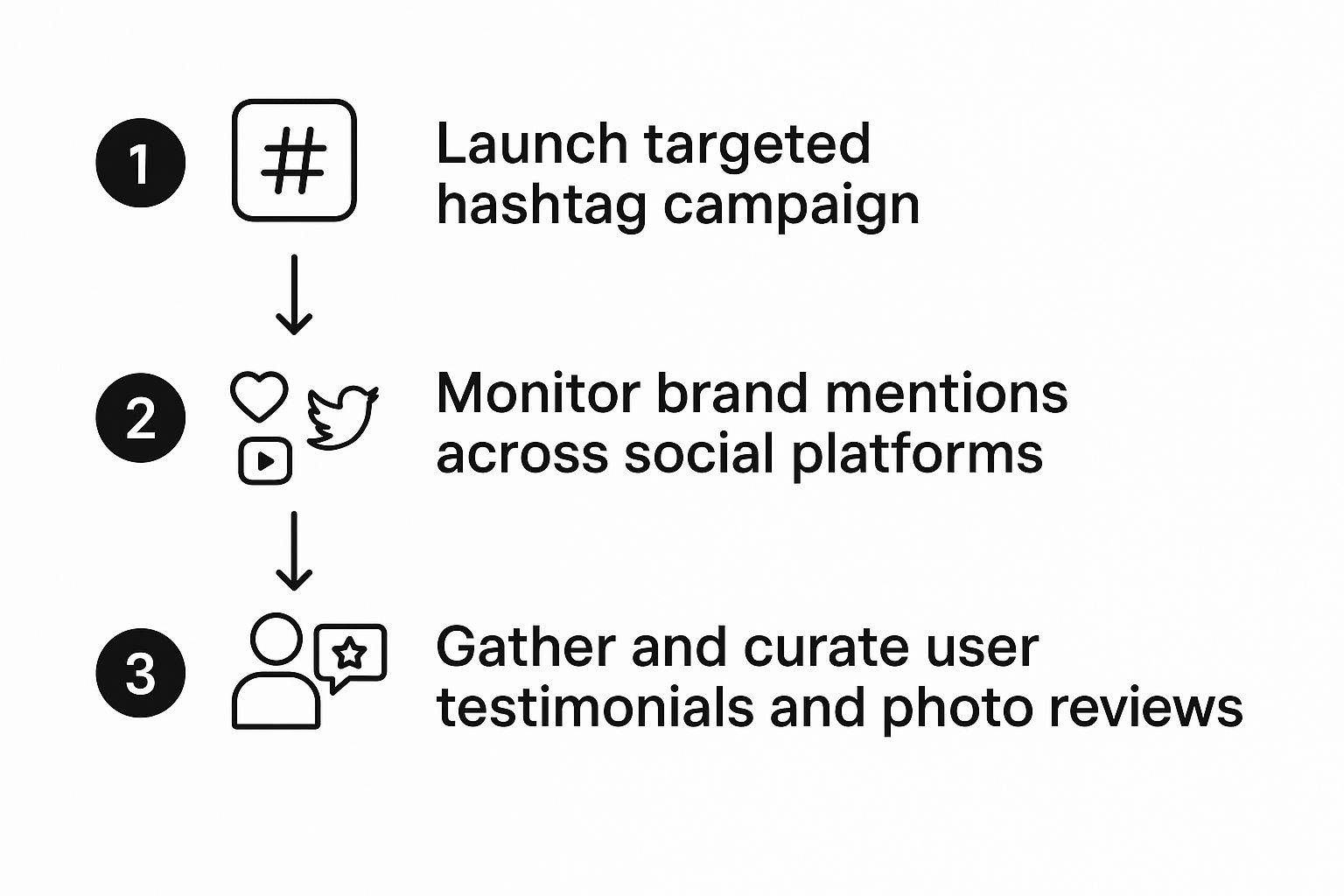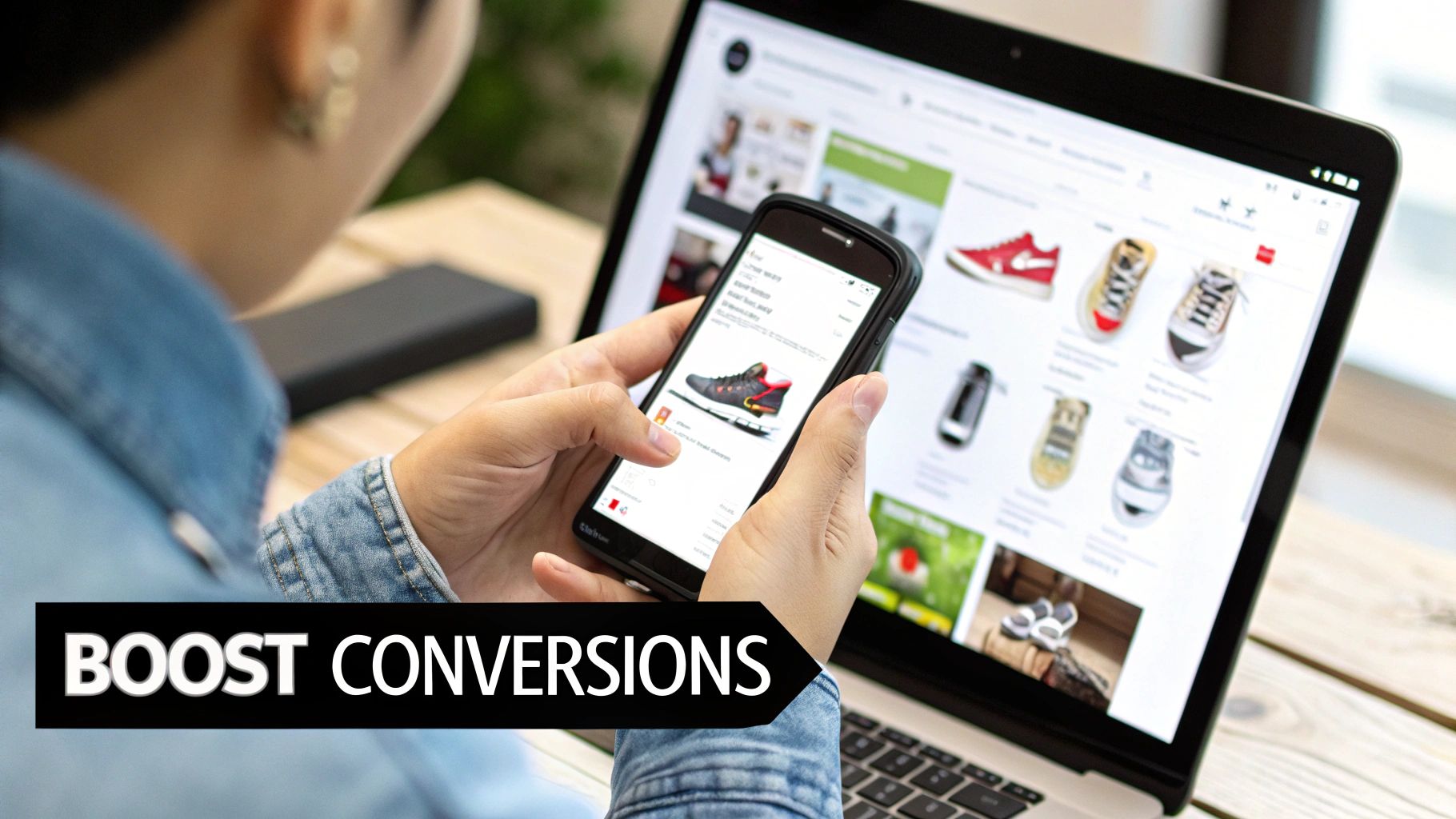
Master UGC Content Creation for Authentic Marketing
Discover the power of UGC content creation. Learn how to leverage authentic content to boost engagement and grow your brand effectively.
So, what exactly is user-generated content (UGC) creation? Think of it as brands passing the microphone to their biggest fans. Instead of creating perfectly polished ads in a studio, they encourage their actual customers, community members, and even employees to create and share their own original content.
This isn't about staged photoshoots. It's the real deal: authentic photos, unboxing videos, honest reviews, and social media shoutouts from people who genuinely use and love a product. It's the ultimate form of social proof.
The Power of Authentic Marketing with UGC

Let's be honest, the marketing playbook has changed. People are tired of slick, impersonal ads that feel completely disconnected from their real lives. We've all developed a pretty good filter for overly-produced corporate content.
What do people crave instead? Authenticity. They want to see real experiences from real people. This is where UGC isn't just a fleeting trend—it's become a powerful cornerstone of modern marketing.
Think about it this way: are you more likely to try a new restaurant because you saw a glossy billboard or because a friend you trust raved about it? It’s the friend’s recommendation, every time. UGC works on that exact same principle. It taps into the power of social proof, building instant credibility that a traditional ad just can't buy.
Building Trust Through Raw Authenticity
Trust is the most valuable currency a brand can have today. And the fastest way to lose it? Inauthenticity. Consumers can spot a fake a mile away, and their patience for traditional advertising is wearing thin.
The numbers don't lie. One study found that 79% of people say UGC heavily influences their buying decisions. That’s a massive signal that people trust other people more than they trust brands. UGC feels unfiltered, honest, and relatable.
This raw quality creates a real connection. It’s not just about showing off a product; it’s about sharing a genuine experience. That shared experience is what builds a community around your brand, turning customers from passive buyers into passionate advocates.
UGC is the modern-day word-of-mouth. It transforms customers into a volunteer marketing force, building a foundation of trust that traditional advertising simply cannot replicate.
A Scalable Engine for Genuine Connection
Beyond building trust, UGC has a huge practical advantage: it's a scalable content engine. Constantly dreaming up and producing fresh, high-quality marketing material is a grind for any team, big or small.
By inviting your audience to co-create with you, you unlock an endless stream of creative, relevant content. It’s not only more cost-effective, but it's also more resonant with your audience.
This approach does more than just fill your content calendar—it brings a rich diversity to your brand’s story. Every piece of UGC is a unique perspective, showcasing your product in countless real-world situations. This collection of authentic stories makes your brand feel more human, approachable, and real. It’s how you build a powerful, community-driven brand, one post at a time.
Why UGC Just Works Better Than Branded Content
The move away from glossy, brand-perfect ads toward real, user-driven stories isn't just some fleeting trend. It’s a fundamental shift in how people decide what to buy. Professional content still has its place, of course, but the numbers don't lie: UGC content creation gets better results where it counts. It all comes down to a simple, powerful idea: people trust other people way more than they trust ads.
Think about it. You see a perfectly staged photo of a coffee mug on a brand’s Instagram. It's gorgeous, the lighting is perfect, everything is pristine. Now, imagine seeing a customer’s candid shot of that same mug on their cluttered desk during a hectic workday, captioned, "Literally the only thing getting me through this Monday." The first image sells a product. The second sells an experience—and that’s what connects.
The Unbeatable Power of Authenticity and Trust
At its heart, UGC works because it’s built on a foundation of trust. Today’s buyers, especially Millennials and Gen Z, are sharp. They can spot a sales pitch from a mile off and have a built-in skepticism for traditional marketing. They’re looking for something real, something they can relate to, which is a high bar for most branded content to clear.
User-generated content slices right through that noise by offering genuine social proof. When someone sees real customers enjoying a product in their actual lives, it confirms the brand’s promises in a way no slick commercial ever could. That raw, unfiltered perspective builds a level of credibility that’s almost impossible to fake.
It's no surprise that a staggering 93% of consumers find UGC helpful when they're deciding on a purchase. This tells us everything we need to know: authentic proof from peers is now a non-negotiable part of the buying journey.
This trust leads directly to better engagement. A post from a real person feels like a recommendation from a friend, which is why it gets likes, comments, and shares so naturally. Branded content, on the other hand, often feels like an interruption, leading to lower interaction and a much less enthusiastic response.
Driving Real Business Results
The magic of UGC isn’t just about feeling good; it has a direct, measurable impact on the bottom line. Brands that get UGC right see real lifts in conversion rates, return on investment (ROI), and overall customer loyalty.
- Higher Conversion Rates: When product pages feature photos and videos from actual customers, conversion rates jump. Seeing a product on different body types, in different settings, or used in creative ways helps people get over their hesitation and picture it in their own lives.
- Increased Engagement: UGC campaigns almost always get more interaction than brand-led efforts. This boosts your organic reach and helps build a real community, turning passive followers into active fans and advocates.
- A Cost-Effective Content Machine: Keeping a steady pipeline of marketing assets is expensive and takes a ton of time. UGC content creation offers a scalable and affordable way to build a diverse library of authentic visuals without the hefty production costs.
It’s becoming impossible to ignore just how important this shift is. User-generated content is now a major force, with research showing that by 2025, 87% of marketers will be using it in their content mix. This isn't a shot in the dark—it's fueled by proven results, as 93% of marketers say their UGC campaigns outperform traditional branded content.
By showing real stories from real people, you’re not just building a stronger brand—you’re building a more profitable one. To see how top brands are already crushing it with this strategy, check out these powerful UGC video examples that are driving serious results.
Exploring the Different Flavors of UGC
User-generated content isn't a one-size-fits-all kind of thing. Think of it more like a buffet of authentic, real-world media, where each dish serves a different purpose for your marketing. Understanding what's on the menu is the first step to building a UGC content creation strategy that actually clicks with your audience.
The real magic of UGC is its flexibility. One type might be perfect for getting your name out there, while another is a powerhouse for sealing the deal on a product page. Let's dig into the most common and effective formats you'll come across.
The Power of Visuals and Social Proof
Some of the most powerful UGC is the stuff you can see. It offers instant, relatable proof that real people are out there using and loving your products in their everyday lives. These formats are absolute gold on platforms like Instagram, TikTok, and Pinterest.
-
Customer Photos: This is the OG of UGC. When a customer shares a photo of themselves with your product—whether it’s a new jacket, a lamp in their living room, or their morning skincare routine—it’s an endorsement that builds instant credibility. No ad can beat that.
-
Video Content (Unboxings, How-Tos, Testimonials): If photos are powerful, video is the undisputed king of engagement. Authentic clips like unboxing videos capture that pure, unfiltered excitement. How-to tutorials show your product in action, and a heartfelt video testimonial delivers the kind of emotional gut-punch that scripted commercials can only dream of.
-
Social Media Mentions and Stories: Never underestimate the simple tag. A quick shout-out in an Instagram Story or a mention on X (formerly Twitter) is a mini-review that spreads your brand name organically through trusted circles of friends.
If you're looking for some real-world inspiration, checking out some of the top UGC content examples is a great way to get the creative juices flowing for your own campaigns.
Text-Based Content That Builds Confidence
While flashy visuals tend to get all the attention, text-based UGC is the quiet workhorse that builds deep, lasting trust. This is the stuff that helps hesitant buyers make confident decisions, and it's essential for your product pages, website, and even your SEO.
It's not just fluff, either. A recent study found that a staggering 50% of customers trust online reviews just as much as a personal recommendation from a friend. That shows you just how critical text-based proof is when someone's about to click "buy."
Here are the most common forms:
- Product Reviews and Ratings: These are the foundation of trust in e-commerce. Star ratings and detailed reviews on your site or places like Amazon give shoppers the direct, honest feedback they need to overcome their final hesitations.
- Testimonials: A hand-picked, glowing quote from a happy customer is a killer asset for landing pages, emails, and ads. It’s a short, sharp burst of validation that says, "this really works."
- Blog Post Reviews: An in-depth review from a blogger your audience already follows? That's a massive win. This long-form content drives traffic and acts as a powerful third-party endorsement that you just can't buy.
This infographic breaks down a simple, three-step approach to actively find and manage all this amazing content.

As you can see, a great UGC program isn't just about waiting for content to appear. It’s a mix of kicking things off with smart campaigns and keeping your ear to the ground.
To help you decide which content type fits your goals, here’s a quick breakdown of the most common formats and where they shine.
Comparing UGC Formats and Their Marketing Impact
| UGC Format | Primary Use Case | Most Effective Platform | | :--- | :--- | :--- | | Customer Photos | Building brand community and visual social proof | Instagram, Pinterest, Facebook | | Video Unboxings/Reviews | Generating excitement and showing product features | YouTube, TikTok, Instagram Reels | | How-To Videos | Educating customers and demonstrating value | YouTube, TikTok, Website Blogs | | Written Reviews & Ratings | Driving conversions and building trust at checkout | Product Pages, Google, Yelp | | Testimonials | Overcoming objections on landing & sales pages | Website, Landing Pages, Email | | Social Media Mentions | Spreading organic awareness and engagement | X (Twitter), Instagram Stories | | Blog Post Reviews | Providing in-depth analysis and boosting SEO | Blogs, Affiliate Sites |
Ultimately, the best UGC strategy uses a mix of these formats to connect with customers at every stage of their journey.
Building a Scalable UGC Content Workflow
Turning random customer posts into a reliable content engine doesn’t happen by accident. It requires a plan. A solid UGC content creation workflow is a repeatable system that transforms those authentic, spontaneous moments into powerful marketing assets. It’s the difference between collecting content and building a sustainable program that actually delivers.
Think of it like building a bridge. You wouldn't just start throwing materials together and hope they connect. You'd start with a clear blueprint. A UGC workflow is your blueprint, giving much-needed structure to your creative efforts.
This system shifts you from being reactive to proactive. It lets you scale your program, build real relationships with creators, and make sure every single piece of content serves a clear business goal. Let's walk through the essential steps to build this bridge between your brand and its best advocates.
Define Your Campaign Goals
Before you ask for a single photo, you have to know why you're asking. Your goals will shape every other decision you make, from the type of content you want to the platforms you'll use to find it. A vague goal like "get more UGC" is a fast track to a messy, useless content library.
You have to get specific. Are you trying to:
- Increase conversion rates on a product page? Then you need authentic photos and video testimonials of people actually using that specific item.
- Boost brand awareness for a new launch? A hashtag campaign designed to create buzz and get a ton of social reach is your best bet.
- Build a sense of community and loyalty? You should focus on resharing content that highlights your brand's values and tells your customers' stories.
Clear goals are your compass. They ensure every piece of content you collect and share is pushing your brand in the right direction. This is a foundational part of building a comprehensive user-generated content strategy that gives you a measurable return.
Discover and Source High-Quality Content
With your goals locked in, it’s time to find the good stuff. Think of it as a treasure hunt—and you need to know where to look. Sourcing isn't a passive activity; it requires you to actively look across multiple channels to find the best content your community has to offer.
Start by keeping a close eye on the channels where your audience already hangs out. This includes:
- Branded Hashtags: Create a unique, memorable hashtag for a campaign or just for general brand mentions. Make it dead simple for people to tag you.
- Platform Mentions: Actively track every time your brand is tagged or mentioned on Instagram, TikTok, X, and anywhere else your people are.
- Review Sites: Customer reviews on your own site or third-party platforms are often goldmines of powerful, text-based UGC.
Don't just sit back and wait for content to fall into your lap. Be proactive. Run contests, launch specific photo challenges, or just reach out to customers who have shared great feedback.
Secure Permissions and Manage Assets
This is, without a doubt, the most critical step from a legal and ethical standpoint. Just because someone tags your brand doesn't give you a free pass to use their content in your marketing. Using a creator's work without their explicit permission is the fastest way to destroy trust and get your brand into some serious trouble.
Always, always follow a clear process for getting usage rights:
- Reach Out Directly: Slide into their DMs or leave a public comment.
- Be Specific: Tell them exactly how and where you want to use their content (e.g., "on our Instagram feed," "in a paid social media ad").
- Get Explicit Consent: You need a clear "yes" or have them reply with a specific confirmation hashtag. For high-value content or anything you plan to use in ads, a formal content licensing agreement is the way to go.
Once you have permission, get that content organized in a central asset library. Tag every piece with the creator's handle, the usage rights you secured, and the campaign it belongs to. This simple system will save you from legal headaches and make it easy for your team to find the right content for any marketing need.
How UGC Drives Consumer Purchasing Decisions

User-generated content does way more than just get your name out there; it draws a straight line from authentic content to actual revenue. The magic behind UGC content creation is how it taps into a powerful psychological trigger: social proof.
Think of it like walking down the street and seeing a crowded restaurant. You immediately assume the food must be good, right? UGC is the digital version of that.
When potential buyers see real people—not paid actors—using and loving a product, it starts to break down their natural hesitation. Every unboxing video, every tagged photo, every genuine review acts as a little piece of evidence that your product actually works. This kind of validation from a peer builds a level of trust that a slick, polished ad campaign just can't buy.
And this isn't just a hunch; the numbers back it up. A huge 79% of consumers say UGC impacts their purchasing decisions. Even better, adding UGC to your product pages can boost conversion rates by an incredible 161%, showing just how directly it turns casual browsers into buyers. You can dig into more of the data in this UGC statistics report from Inbeat Agency.
The Power of Relatability in Conversions
Let's be honest, branded content usually shows a product in a perfect, idealized world. It looks great, but it can also feel a bit distant. It makes it hard for someone to imagine how that product fits into their own, sometimes messy, real life.
UGC completely shatters that barrier with raw, unfiltered relatability.
Seeing a new couch in a real, lived-in living room or a foundation on someone with a similar skin tone gives context that a professional photoshoot just can't match. It’s that "seeing is believing" moment that helps a shopper truly picture themselves using your product—a crucial step before they decide to buy.
This kind of real-world proof answers the silent questions every customer has:
- Will this actually look good on me? Customer photos show off your product on all kinds of body types and skin tones.
- Is it a pain to set up or use? A quick "how-to" video from another user is often way more convincing than a brand's official tutorial.
- Is it really worth the price? An enthusiastic video review provides both the emotional and practical justification someone needs to feel good about the cost.
By answering these unasked questions with authentic visuals and stories, UGC dramatically shortens the path to purchase. It provides that final nudge a hesitant buyer needs to confidently click "Add to Cart."
From Social Posts to Sales Surges
The link between one great piece of UGC and a jump in sales can be surprisingly direct. Imagine a customer posting an Instagram story about how your product solved a very specific problem for them. That's not just a post—it's a mini case study broadcast to their entire network.
For instance, a travel blogger might share a clip of your backpack holding up perfectly during a rough hiking trip. Their followers, who already trust their opinion, see this genuine endorsement and are immediately influenced. A single piece of content like that can create a wave of interest, sending qualified traffic straight to your product page and causing a very real spike in sales.
Brands that actively encourage and feature this kind of content create a powerful cycle. More UGC leads to more social proof, which drives more confident purchases, which then inspires even more UGC. This transforms your customers into your most effective sales force, proving that a UGC content creation strategy isn't just another marketing expense—it's a direct investment in growing your revenue.
The UGC Creator Economy Isn't Just a Trend—It's a Market Force
The world of UGC content creation is about more than just authentic posts. It's a full-blown economic engine that's completely rearranging marketing budgets. Brands are waking up and moving away from expensive, glossy studio ads in favor of content that’s not only more affordable but also far more relatable because it’s made by real people.
This shift has created a bustling ecosystem where creators and brands connect, striking deals and building value together.
At the heart of it all is a simple, powerful idea: UGC delivers a massive ROI. It completely sidesteps the huge overhead of traditional ad campaigns and the eye-watering fees charged by top-tier influencers. Instead, brands get access to a scalable stream of content that actually connects with people, driving better engagement and more sales for a fraction of the cost.
The Financial Case for UGC
The numbers don't lie. As of 2025, the user-generated content market has skyrocketed to a valuation of over $7.6 billion globally. That's a staggering 69% jump from $4.5 billion just a year before. This explosive growth is a direct result of brands looking for smarter ways to spend their money and consumers demanding more genuine interactions. You can find more details on this market expansion on whop.com.
This change has given rise to a new breed of creator—one who specializes in making authentic, on-demand content. These aren't mega-influencers with millions of followers; they're everyday people who have perfected the art of creating videos and photos that feel real. For any marketing leader trying to make a smart financial move, getting to know the role of a dedicated UGC content creator is the first step toward a sustainable growth plan.
UGC is no longer just another marketing tactic; it's a strategic financial investment. It lowers customer acquisition costs by using the most trusted voice there is: the voice of another customer.
For creators trying to make a living in this space, it’s also crucial to get savvy about things like UGC marketplace fees to make sure they’re earning what they're worth. By leaning into this new economic model, brands don't just get better content—they empower a global community of advocates, creating a powerful marketing engine that fuels itself and drives real, bottom-line results.
Got Questions About UGC? We’ve Got Answers.

As you start planning your own UGC program, it's completely normal for a few questions to pop up. Getting the details right is what separates a good strategy from a great one.
Let’s tackle some of the most common questions brands have when they dive into UGC content creation. We'll clear up the confusion around creators, talk about payment, and cover the essentials of legally using content. Nail this stuff from the start, and you'll be set up for the long haul.
UGC vs. Influencer Marketing: What’s the Real Difference?
This is easily one of the biggest points of confusion. On the surface, UGC and influencer content can look pretty similar, but their motivations are worlds apart. It's like getting a recommendation from a good friend versus seeing a paid celebrity endorsement on a billboard.
The key difference comes down to authenticity and where the content originates.
- UGC: This is the good stuff—organic content from real customers sharing their thoughts because they genuinely love your product. No payment was exchanged upfront; the motivation is pure passion.
- Influencer Marketing: This is a straightforward paid partnership. A creator is paid to promote a product to their audience. It's a transaction, an advertisement designed to get your brand in front of new eyes.
While the lines can get a little blurry—especially when brands start paying for content that looks like UGC—the original intent is what separates them. UGC is born from genuine advocacy; influencer marketing is a paid ad campaign.
Do I Have to Pay for User-Generated Content?
Ah, the million-dollar question. The short answer is: not always.
When a fan organically posts about you on their own channels, you don't pay for that post. But that doesn't mean it's a free-for-all. Before you even think about reposting it on your own channels, you absolutely must get their permission.
Just because someone tags your brand doesn't give you a free pass to use their content. Always, always ask for permission first. It protects you legally and keeps the trust you've built with your community.
Lately, though, more brands are running paid UGC campaigns. This means they commission content from creators for a fee. It gives them more control over the final product and guarantees they have the rights to use it. Many of the most successful brands use a hybrid approach—they celebrate and encourage organic posts while also setting aside a budget for paid creation.
How Do I Get Legal Permission to Use Content?
This part is non-negotiable. Using someone's photo or video without their consent is the fastest way to wreck your brand’s reputation and land in hot water.
The best practice is simple: contact the creator directly. Every time.
- Reach Out: Drop a DM or leave a public comment on their post. Keep it friendly and professional.
- Be Clear: Tell them exactly how you want to use their content. Is it for your Instagram feed? A paid ad on Facebook? Your website's homepage? Be specific.
- Get It In Writing: You need a clear, explicit "yes." For anything beyond a simple social media share, especially for paid ads, it’s a good idea to have a formal content license agreement. This should spell out the scope, duration, and any compensation.
Never assume you have the right to use someone's content without their direct approval. It’s a simple step that protects everyone involved.
Ready to create viral content faster than ever? With ViewPrinter, you can generate, edit, and schedule all your social media posts from one powerful platform. Start creating with ViewPrinter today and see the difference AI can make.